Derbyshire’s link to the most famous WW2 Battle of Britain fighter squadron
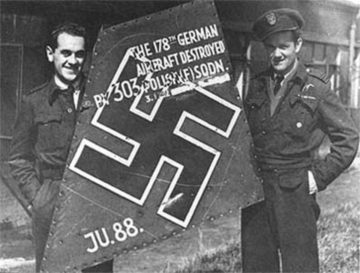
The bombing of the Tarmac plant at Dalton quarry during WWII was witnessed by local people in the village and their recollections are to be found elsewhere on this website. However, little was known about the details raid until now.
We are indeed indebted to the meticulous work of Frank Pleszak who has researched the event in detail which he has published on his blog. The following is an excerpt from that blog.
His story began when he came upon a plaque on Low Leighton Road New Mills. The plaque described an incident on 3 July 1942 when two German Junkers bombers wreaked death and destruction on the remote and quiet Derbyshire town. The aeroplanes had destroyed an old chapel that had previously stood there and killed two people.
Intrigued he looked into the records of the event. What he found was fragmented and disjointed so he decided to bring the information together and discovered on a visit to a small museum in London that a section of one of those raiding aeroplanes is still proudly on display as a trophy, not only commemorating the event, but celebrating the incredible input of Polish Pilots in WW2.
Frank tells us that the records showed that by the summer of 1942, at the height off WW2, the German large-scale Blitz’s had stopped but ‘hit and run’ German airborne raiders were regularly flying sorties over northern England. These were not considered a sign of a concerted renewed bombing campaign but as isolated tactical attacks on specific targets.
It seems that German intelligence had identified the De Havilland factory at Lostock near Bolton as a key target. It was a major manufacturer of variable pitch propellers, the main supplier to all the UK aeroplane manufacturers and as such worthy of the risky daylight raid.
From a report based on extracts of contemporary RAF interrogations of Luftwaffe prisoners of war it is clear that discussions had been ongoing in the officers mess of the 2nd Küstenfliegergruppe 106 (2nd Coastal Command Group 106 – 2./KGr.106) about the feasibility of daylight low level bombing of UK targets using their versatile twin engined Junkers Ju 88 A-4 fast bombers. Towards the end of June, the subject of a Lostock raid had arisen. Staffelkapitän (Squadron Commander) Hauptmann Hans Bergemann, against protestations, was adamant that a successful daylight attack using two aeroplanes was feasible and managed to convince his (seemingly sceptical) Gruppenkommandeure Major Ghert Roth that an attack on Lostock could be successful and should proceed.
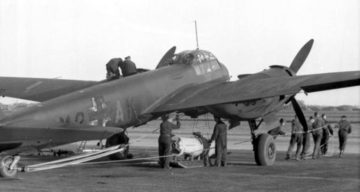
Hauptmann Bergemann together with 2./KGr.106’s other most experienced crew was selected for the operation. They spent the following week practising low-level attacks. The flight in and out was to be undertaken at wave/tree top height all the way and the bombing was to be carried out from just 60 feet. Tenuous link coming…. Also, like the Dambuster’s who practised their low-level attacks just a few miles away from New Mills at Derwent Reservoir the purpose of the training was kept secret and the crews involved were not told of their intended targets until the morning of the attack on 3 July itself.
Both Ju 88’s were to be heavily loaded with four 250Kg HE (High Explosive) bombs with 8 second delay fuses on the wing racks and a mixed load of 50Kg HE and 1Kg incendiaries in the fuselage bomb bay. To maximise flying time, they would fly unloaded from their home base in Brittany at Dinard Pleurtuit to the airfield at Llanveoc-Poulmic near Brest where they would be refuelled and loaded with their deadly arsenal.
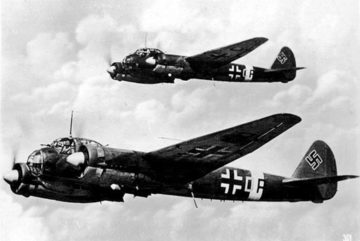
Their flight plan would take them in four legs north from Llanveoc-Poulmic across the English Channel to Land’s End, up the Irish Sea to St David’s Head in south Wales, onto a point south of the Isle of Man, before a final run-in across Morecambe Bay to Lostock. With their maximum bomb load and even with full fuel tanks a return by the same route back down the Irish Sea to their base in Brittany would be impossible. Their return home, possibly the most dangerous part of their mission, would take them in a south-easterly direction straight over the heavily defended RAF bomber county of Lincolnshire to The Wash then out over the North Sea to their landing destination of Amsterdam- Schiphol (though I have seen suggestions it may have been Soesterberg Airfield in Utrecht). There were concerns that even this route would be too far for their fuel reserves and their contingency was to fly their last leg, at least in part, on a single engine.
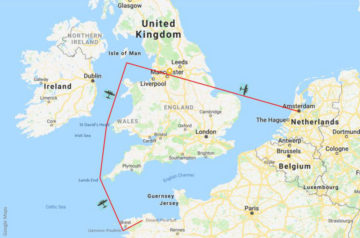
The weather forecast for Friday 3 July 1942 was predicted to be low cloud cover all the way to Lostock. The two Ju 88’s were made ready and at around 18:00 (UK time) using rocket assisted take-off the two fully laden Ju 88’s departed Brittany on their mission to the north west of England.
Their first three legs were uneventful and went according to plan. They maintained radio silence flying below radar detection and avoiding Liverpool’s anti-aircraft guns until they intercepted the dot-zone of a radial beam from the German navigational beacon ‘Electra-2’ just south of the Isle of Man. Passing through the continuous-zone tone the pilots banked right, turning onto their final leg and run in to Lostock once they heard the pre-defined dash-zone tone.
Their final leg should have taken them over the coast at the Ribble Valley estuary straight to Rivington Reservoir then a final right turn to fly south-west at zero feet for 2 miles to the propeller factory at Lostock.
However, cloud cover was lower than expected and as they crossed the coast at about 19:45 it appears to have been made further south than planned. Adding to the confusion they may have been using Luftwaffe maps identifying Lostock Hall 5 miles further to the north near Preston (which had been attacked several times previously) rather than Lostock near Bolton. If this was the case it would have been almost impossible to identify their intended target.
Neither aeroplane was able to spot either the reservoir or the propeller factory at Lostock. With limited fuel reserves there was almost no time for a search and in Bergemann’s lead aeroplane an argument seems to have taken place about what to do next. No bombs were dropped and maintaining close formation the two Ju 88’s continued south-easterly passing low of Trafford Park just to the West of Manchester (where they could have released their bombs to good effect, but didn’t) and then on to the south of Manchester at Withington where they were recognised by a member of the RAF who was on leave. By 20:10 the incursion was identified as raid 299, and an Air Raid Alert raised for Manchester which was in place until 20:23. The two raiders were again recognised a few miles further east low over Burnage heading south-east.
(There are some uncorroborated and unlikely accounts that they circled over Avro’s Woodford aerodrome south of Manchester where Lancaster bombers were built. Again, it would have been a good opportunity to cause havoc. It may have been a secondary target, but if it was, they took no action.)
Whatever route they took they then passed into Derbyshire flying very low and fast south-easterly up the River Goyt before veering north-easterly over New Mills town centre. At 20:00, just before the town centre, the two aeroplanes seemed to have split up slightly. One of raiders banked tightly and dropped bombs near Mousley Bottom Gasworks and Torrs Gorge near to Lowes Mill (now known as Torr Vale Mill) and the railway line. The other took a wider arc heading for the railway viaduct where it dropped two bombs in Woodside Street.
Dropping incendiaries and firing indiscriminately, their flight took them over the cricket ground on Church Road firing machine guns as they did so before they banked further round to the left where they dropped bombs on Low Leighton Road and then followed the Sett Valley to Hayfield where they dropped further bombs. They then banked round to the right over Kinder Scout and re-established their exit route in a south-easterly direction over the Dark Peak.
They appeared to jettison their final bombs over Darlton Quarry at Stoney Middleton before strafing Chatsworth House as they made good their escape.
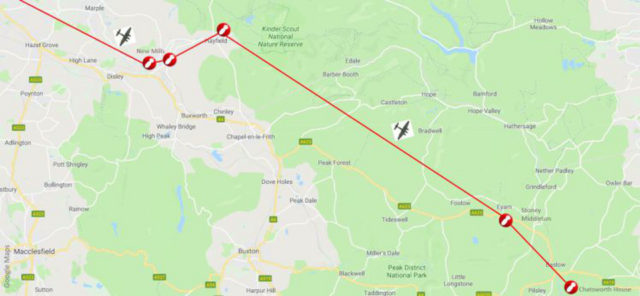
By the time the two German Raiders had departed the Chatsworth House area the R.O.C. post (Royal Observer Corps) at Collingham, Nottinghamshire were well aware of the incursion and reported their movements (now identified as Raid 301) with a series of accurate plots to 12 Group Fighter Command.
At New Mills the raid had come as a complete surprise, no Air Raid Warning was given and as the aeroplanes approached there was confusion about their identity, many thinking that they were RAF on low flying exercises.
At Mousley Bottom machine gun fire had caused holes and small fires in a Gas holder and an adjacent Purifier but rapid work by staff and the Fire Brigade from the nearby fire station soon had them under control and the damage patched up. There was no disruption to supply. Two bombs were dropped. The first narrowly missed the Gas works before exploding in the river. The other also landed in the river but failed to detonate. It was removed by workers from the mill and moved up the bank, for which thirteen men were later prosecuted for “exposing the mill to greater damage should the bomb detonate”.
There were no fatalities, but the initial bombing had done some, and in some cases substantial damage, windows and window frames were blown out of Lowes Mill, there was also damage to the railway signal box and the railway station itself. Some of the houses and shops along Union Road and Market Street sustained extensive damage. Several incendiary bombs were also dropped, but the majority failed to ignite and were collected the following day.
The second more southerly aeroplane, had also dropped two bombs, both on Woodside Street. One had landed at the junction of Albion Road and Woodside street. It failed to explode, it had its fuse removed and was then taken to the Police station. The other allegedly had crashed through a window at the labour exchange before exploding in the railway embankment. Again, there were no fatalities, but one resident was treated for severe shock.
As the aeroplanes departed New Mills centre they raced over the cricket pitch and over the adjacent St. Georges Church. Machine gunning had torn up the cricket pitch and scattered a game that was in progress between Hayfield and Birch Vale juniors but thankfully with no casualties.
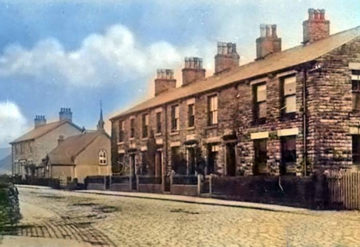
However, at Low Leighton a single bomb narrowly missed the former workhouse, which at that time was in use as Ollersett View Hospital, causing extensive damage to the roof, windows and nearby houses. But on the opposite side of the road the tin built Wesleyan Chapel and two adjacent cottages (Whitefield Villas) were completely destroyed.
The occupants of the two cottages Mr and Mrs Handford and Mr and Mrs Travis (and their two children were all away. But 18-year-old Maurice Handford, his 10-year-old sister Joan and their grandmother Mrs Gillies, who was 75, were all indoors. Maurice and Mrs Gillies were trapped in the rubble and seriously injured but Joan Handford was sadly killed immediately. The chapel’s caretaker 79-year-old Daniel McKellar was also seriously injured and died the following day. There were ten others injured in the raid and there were 150 reports of damage to property. Maurice Handford and Mrs Gillies spent several weeks in Ollersett View Hospital before being transferred to a hospital in Glossop. Maurice bore the scars for the rest of his life, but Mrs Gillies never got over the trauma of the attack and died a year later.
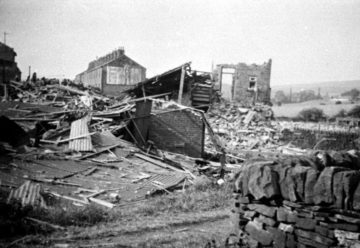
Hayfield was similarly taken by surprise. The aeroplanes flew over Hayfield Park releasing two 50Kg HE bombs and some incendiaries. Three stone cottages on Spring Vale Road just behind the centre of this beautiful picturesque tourist town were obliterated. Reports from the time tell of a lack of panic and hysteria. The Home Guard, special police and the civil defence services were soon on site. Many had rushed there without time to put their uniforms on and with only their helmets for protection. They worked with amazing strength and speed, and yet with extreme care sifting through the rubble for survivors.
Sadly, there were six fatalities: Albert and Edith Gibson, their two daughters Gladys and Margaret, together with Hannah Robinson and Freda Thorpe, a 10-year-old evacuee from Belle Vue in Manchester. Freda’s two brothers and grandmother all survived.
Locals around Stoney Middleton remembered “that the planes were so low they blew leaves off the trees as they flew over. Then followed a terrible bang and lots of smoke with people running and shouting. However, the plant was soon repaired and back into full production.” There were no casualties, but a crusher shed, and a blacksmith’s shop were damaged.
At Chatsworth the roof, north and west side of the house were hit by machine gun fire, some nearly hit rare paintings in the library. The house at that time was used as a school for 250 girls evacuated from a private school in Penrhos North wales. Fortunately, the girls were all in the main hall for prayers and again there were no casualties.
12 Group Fighter Command Sector Control were advised that two Ju 88’s were flying at zero feet, forty miles west of Lincoln heading in an easterly direction. The Sector Controller Sqn Ldr Mawdesley immediately scrambled two flight sections from the RAF base at Kirton in Lindsey 20 miles north of Lincoln.
Based at RAF Kirton in Lindsey was Polish 303 Squadron who had arrived, in mid-June from RAF Northolt in London with nineteen Spitfires, for rest and replenishment. 303 Squadron is arguably the most famous fighter squadron of all time, being the squadron that scored the highest number of ‘kills‘ in the Battle of Britain two years previously. They were there with several of their ‘aces’ and were commanded by the world-famous Battle of Britain ace, highly decorated, enigmatic, and colourful character that was Sqn Ldr Jan Zumbach. He was one of the founding pilots of 303 Squadron and his total officially credited wartime tally was 12 destroyed, 2 shared destroyed, 5 probably destroyed, and 1 damaged.
Since arriving at RAF Kirton in Lindsey their flying had been limited to training, patrols and escort duties. It was considered boring and had led to some cavalier flying around the airfield and some conflict within the squadron. A patrol in the morning of 3 July had been uneventful but as the two flight sections were scrambled in the evening it was time for some real action again.
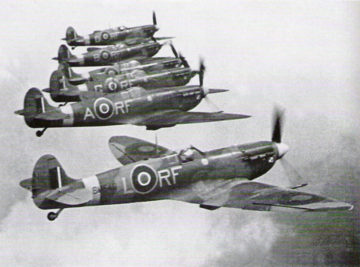
Yellow Section were airborne at 20:05 and circled the airfield waiting for White Section. They were joined at 20:10 by the other two Spitfires. To avoid any language problems Sqn Ldr Mawdesley handed control of the operation to Polish Controller Flt Lt Ostaszewski who ordered both flights over Lincoln on a vector of 190 degrees and instructing them to maintain sufficient height to remain in radio contact.
Cloud cover was still very low with a base of around 1000 feet. The four Spitfires were flying at 500 feet when Yellow 1 (Wünsche) in the lead, sighted two aeroplanes two miles east of Lincoln flying at 0 feet heading east in close formation, and identified them as Ju 88’s. He immediately notified both sections and changed course and closing in from the rear-above-left opened fire on both Ju 88’s using short bursts from his two cannon and four machineguns from about 300 yards in order to slow them down and ensure the other Spitfire attacks would be more effective. The attack must have caught the two Ju 88’s completely by surprise as they had no time to climb into the thick cloud for protection.
As the two Junkers split, Yellow 2 (Popek) followed on attacking Fw Majer’s M2-BK as it veered towards the north, diving from the rear using long bursts from his cannon and machineguns, firing from 250 yards and breaking off the attack at about 20 yards. Uffz Frank, the air gunner in the rear upper turret had returned fire causing damage to Popek’s propeller, but the Ju 88 was already on fire in both engines and loosing height. It crashed in flames at 20:25 into a tree and farm buildings at Limes Farm near Baumber. All four crew members died instantly.
Whilst Yellow Section had been concentrating on M2-BK White section had engaged Hptm Bergemann’s M2-KK. White 1 (Kołecki) attacked with a series of short bursts from the rear-above. White 2 (Rokitnicki) attacked from the rear-right-above firing from a distance of 300 yards down to 50 yards using as series of short bursts. Once M2-BK had crashed Yellow 2 also joined in the pursuit of M2-KK whose plight was hopeless. Popek fired his remaining ammunition before making dummy attack runs to cause confusion.
Bergemann with his starboard engine on fire managed to crash land his stricken aeroplane in a field at Odlings Farm between Aswardby and Harrington. As the Spitfires circled around like vultures the four crew members were all seen to get out of the wreck and run away. Within minutes the aeroplane ignited with a brilliant white phosphorous explosion as the crew purposely destroyed the remnants of the aeroplane. It was significantly the 178th enemy aircraft attributed to 303 Squadron. The four Spitfires were all recovered safely back at Kirton in Lindsey between 20:45 and 20:55, albeit with Popek’s Spitfire RF-K with a damaged propeller. The four Polish pilots were each awarded with ½ a kill each.
As German aerial activity over Lincolnshire was by that time a rare occurrence, the shooting down of the two German raiders became quite a story as recounted by (bored) British Night Fighter pilot Alastair Goodrum who was based at Kirton in Lindsey at that time:
“Kirton in Lindsey mess was full of Polish Spitfire pilots from 303 Squadron led by Sqn Ldr Jan Zumbach. They were a grand bunch of chaps, full of beans and they would, listen to our woeful tales of fruitless chases then shoot us a line about their recent slice of real action near the airfield and we’d ll have a good laugh. I was very envious of their cannon-armed Spits, though.”
Local papers sensationalized the event with articles such as:
“How two Nazi raider planes which bombed houses and machine-gunned civilians and children in the North Midlands on Friday evening were brought down by Polish airmen makes one of the most dramatic air raid stories of the year”.
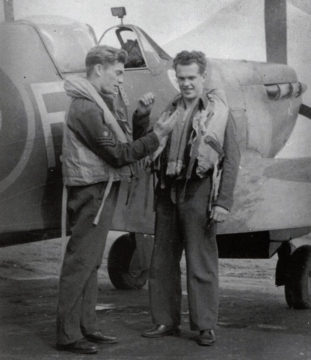
Though a relatively very brief encounter for 303 Squadron it was nevertheless a significant piece of action following the heady days of the Battle of Britain in 1940. The crash sites were visited by numerous members of the squadron and two Iron Cross 2nd Class (EKII) were recovered from the wreckage of M2-BK (one dated 1939). However, a panel section of the (largely) undamaged tail fin adorned with a Nazi Hakenkreuz (Swastika) was removed from M2-KK together with a dinghy paddle and machine gun.
For a while the fin section was proudly hung on the wall of Sqn Ldr Jan Zumbach’s office at Kirton in Lindsey, but it was too valuable an asset to remain there seen only by a privileged few. It was soon adorned with details of the event and used in numerous publicity photos taken in August in preparation for Squadron Day on 1 September. Most of the pictures feature Zumbach’s Spitfire VB (BM144 – RF-D, even though it wasn’t one of the aeroplanes used) complete with his war tally (at that time: 11 destroyed, 4 probably destroyed), the 303 Squadron Kościuszko logo, and Zumbach’s personal Donald Duck logo (apparently because his distinctive nose resembled a duck’s beak), and one of the Iron Crosses recovered from M2-BK attached to the side.
The four German airmen that died in M2-BK are buried in the Deutscher Soldatenfriedhof in Cannock Chase Staffordshire which contains the bodies of many German servicemen who died in the UK during both world wars. All four crew members of M2-KK were quickly captured by the local Home Guard and remained as prisoners of war. I have no information on what happened to these, but if I find out I’ll update this blog.
Flt Sgt Kazimierz Wünsche was eventually promoted to Flight Lieutenant and returned to Poland after the war. He avoided communist persecution and joined the People’s Polish Air Force but was expelled for political reasons. He later joined the Air Medical Service where he flew air/sea rescue operations. He died in Warsaw on 10 July 1980 and is buried in Powązki Military Cemetery Warsaw.
Flt Sgt Mieczyslaw Popek was killed aged 27 on 14 January 1944 after completing a training flight in a Miles Master III at Tollerton near Nottingham. He is buried in the Polish War Cemetery in Newark-on-Trent Nottinghamshire.
Plt Off Tadeusz Kołecki was by 14 September 1943 promoted to Flying Officer when he was tragically killed, aged only 24, returning to RAF Northolt following an uneventful escort operation when his engine failed, and he forced landed his Spitfire IX which burst into flames at Sandy Lodge Golf Club in Northwood Middlesex. He is buried at Layton Cemetery Blackpool.
Sgt Aleksander Rokitnicki moved to Canada in 1947 and worked in a research laboratory where he made a significant contribution to the development of the rabies vaccine ERA (‘R’ stands for Rokitnicki). He continued to fly as an instructor for the Royal Canadian Air Cadets. He Died 10 December 2009 and is buried in Toronto.
Sqn Ldr Jan Zumbach eventually became a Wing Commander. He settled in France after the war where he continued his colourful lifestyle. Using Swiss nationality, he flew contraband around Southern Europe and the Middle East. In 1962 he helped creat Avikat, the air force of Congolese breakaway state of Katanga. He went on to deal in second-hand aircraft until 1967 when as John Brown he organised and commanded the eastern Nigerian breakaway state Biafran Air force, flying a Douglas B-26 Invader. He died in France 3 January 1986 in unclear circumstances and is buried at Powązki Military Cemetery in Warsaw.
The De Havilland propeller factory at Lostock was clearly a potential target for the Germans, Luftwaffe reconnaissance photos clearly identify it. It was never attacked during the war; the factory still exists and is part of BAE Systems. A Luftwaffe target map correctly identifies Lostock Hall but incorrectly labels it ‘Luftschraubenwerk De Havilland” (De Havilland Air Screw Factory). It’s hardly surprising that the two Ju 88’s failed to find their target.
The rural, remote isolated villages of New Mills and Hayfield were clearly not any intended, or even mistaken targets even though there were several other bombings and V1’s in the surrounding areas during WW2.
But for me it’s a mystery why the two Ju 88’s took a dog leg that took them over New Mills and Hayfield. My best guess is that the cloud cover was too low along their planned exit route and the flight path up the Sett Valley had less cloud cover and offered a clearer route. The villages of New Mills and Hayfield were the last clusters of buildings they came across before reaching high moorland and were chance to dispose of their loads and at least wreak some damage and possibly also to lighten their load to make themselves more manoeuvrable for the dog-fights that they knew would inevitably come.
The damage at Mousley Bottom and around New Mills station was minimal and soon repaired. There is a report that the unexploded bomb which had been pulled out of the river and left in a wheelbarrow on the muddy bank became quite an attraction until warning signs were eventually erected and the entire area cordoned off by police. There is almost no evidence today of the bombings except for a hole in the wooden fence along Station Road which is alleged to be from a German bullet.
At Low Leighton Ollersett View Hospital has been renovated and converted into luxury flats and renamed as Ollersett House. The two cottages of Whitefield Villas were re-built in their original design, but the chapel was beyond repair and never replaced. The fire Station mentioned at the beginning now occupies the position of the Chapel. After the war a replacement church known as Low Leighton Methodist Community Church was constructed on nearby High Hill Road. At the fire station a plaque commemorates the events in New Mills on that fateful day. Joan Handford and Daniel McKellar are buried at St. Georges Church next to the cricket ground and are commemorated with their names on the War Memorial in the church grounds.
Similarly, in Hayfield the quaint stone-built cottages on Spring Vale Road were never replaced, and no plaque (as far as I know) has ever been erected. In fact, there are no signs at all to give any clue of the carnage and destruction. As at New Mills, the names of those killed are commemorated on the War Memorial in the centre of Hayfield village with the simple inscription “The Following civilians were killed by enemy action – Their name liveth for evermore”
Tenuous link coming…. The Spring Vale Road cottages were less than 100 yards from the birthplace, on Kinder Road, of the actor Arthur Lowe, most famous for his portrayal of Captain Manwaring in ‘Dad’s Army’ who was probably away in the Middle East with the British Army at the time of the bombing.
At Darlton Quarry near Stoney Middleton there are no lasting reminders of the bombings. However, a historical plaque near to the village suggests that quarry was targeted by two Messerschmitt Bf 110’s (Me 110) to disrupt stone production which was of used in the construction industry and for the war effort. It is clear that this was not the case for either point as we now know the bombing was merely an opportunistic raid by two Ju 88’s as the aircraft tried to return to their base. In reality the range of Me 110’s would have been insufficient to carry out such an adventurous raid.
Another tenuous link coming…. The girls at Chatsworth had been relocated from Penrhos College in Wales as their boarding school had been requisitioned by the military for storage purposes. After WW2 the RAF base at Penrhos served as a demobilization camp for Polish servicemen and provided medical care, accommodation and support to those Polish ex-servicemen and women who remained in the UK following the War. It developed into a ‘Polish Village’ with a church, library, common rooms, shop and allotments. It still exists today, run by the Polish Housing Society and has a very significant place in Polish history with many Polish WW2 veterans still having holiday homes there. A poignant plaque, dated 3 May 1947 in the church yard, optimistically states “On the way to free Poland”- for most Poles, like my father, this was to be an unrealised dream as their homeland was lost to the Soviet Union forever in 1939.
There was little actual damage at Chatsworth House though some windows were broken, but a table was damaged, and the bullet hole still remains in the table to this day. The parents of the girls boarding there at that time were so relieved that nobody was injured they collected £50 ‘in appreciation of the skill of the Polish pilots who destroyed the two planes which made the attack and prevented a return visit’.
So as can be seen from the photos some of the most famous pictures of the most celebrated WW2 Battle of Britain Fighter squadron involve a link to the High Peak in Derbyshire near to where I live. The photos include the most significant 303 Squadron trophy – not a relic from the Battle of Britain but the fin section from their 178th kill, a Ju88 bomber that had bombed the rural Derbyshire towns of New Mills and Hayfield.

Amazingly, this trophy still exists, in its original condition together with the dinghy paddle also taken from the same action. They are displayed with pride and honour at, the excellent former Polish Government in Exile’s Embassy, now Polish Institute and Sikorski Museum (PISM) in London. It was an absolute privilege to see it there.
Many thanks to Mark Postlethwaite at (www.wingleader.co.uk) and New Mills Local History Society (www.newmillshistory.org.uk ) for the use of some the pictures.
Very interesting read, my dads cousin was Hannah Robinson, we have been told the story many times about Hayfield but never the whole journey and consequences of the planes.
Thank you.
My mums cousin was Freda Thorpe,they were evacuated to hayfield from Manchester during the blitz.
What a great piece of research, the bombing of Hayfield in particular has been well known in the village. The daughter Hannah Robinson one of the victims is nearing 100 but still going strong in a New Mills residential home whilst Hannah’s granddaughter and family still live in the village.
What has been missing is the story of the raid, the reasons and outcome, now these are available it completes the story which turns out to be very interesting as the impact of the war was clearly demonstrated locally. Thank you .
It was one of these two planes that opened fire on Ecclesall Road in Sheffield. The bullet holes (around 30) are still all visible on the old stone wall.
This was posted on a Sheffield forum.
Sorry for somewhat late reply but I have only just found this topic having googled bullet holes Ecclesall Road. Having served 30 years in the Police in Sheffield I had ample time to ask comrades and older members of the public about the Last War and Sheffield ( a hoby of mine). They are indeed bullet holes on the wall just above Colliegate Crescent, they were made 3rd July 1942 by a belly gunner on one of two Junkers 88 bombers that carried out a long low level attack on aircraft factories around Manchester, not very successfully, they flew very low back across the Penines , bombing a quarry at Stony Middleton, also straffing Chatsworth House before flying across the southern edge of Sheffield and straffing Ecclesall Rd. before flying towards the east coast. they were caught by fighters from 303 squadron who shot both planes down, one crashed no survivors the other belly crashed and all got out then set fire to their plane.
z3navg
A fascinating story, especially as I went to school in Lostock Hall and then worked at the Lostock aerospace site for 43 years.
The Luftwaffe didn’t manage to destroy the site but Bellway finally got it ,,,, it’s a housing estate now